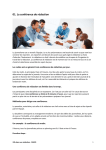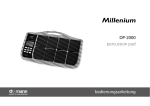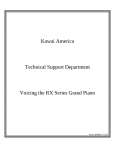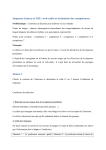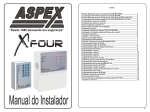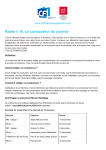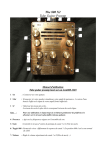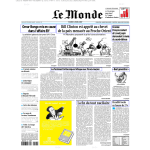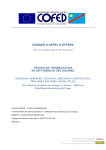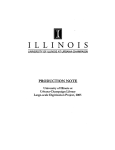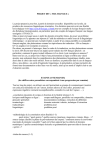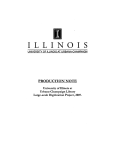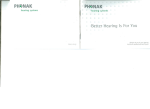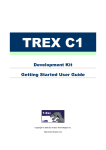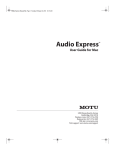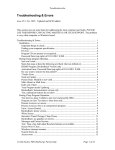Download Radio - CREC International
Transcript
01. The newsroom meeting Journalism is basically teamwork. The anchor(s) need(s) to know what type of stories the reporters are going to work on. The reporters need to know which angle will be used to treat a story. The editor-in-chief needs to round the troops up and organize and distribute work in the newsroom. During the morning meeting, everybody gathers together to choose the stories of the day. Radio stations usually have three newsroom meetings a day The morning one is the biggest one. It usually occurs at 9AM, just after the morning bulletin, and is used to choose the stories of the day. Another one then takes place at the beginning of the afternoon: it is used for rounding up, taking new events into account and adjusting the reports in consequence. Lastly, a final one takes place in the evening, after the last bulletin and before the night shift: during this one, the newsroom rounds up elements and gets the newscasts of following morning ready. A meeting is time-limited Participants are disciplined and respect one another. A meeting is not a boudoir where everybody is free to chatter inanely. It lasts between 45 minutes and an hour, so that the reporters can get to work as quick as possible, and the anchor can start getting the bulletin ready. How to manage a meeting The first way is the authoritarian one. The editor-in-chief comes in with an already completed, non negociable list of stories, and distributes it among the team. The second way is modern management. The meeting begins with a round up of the journalists’s ideas and their point of view on the news, then some adjusting is done taking into account what can’t be missed: meetings that are already scheduled, press meetings, ongoing investigations… 24h in a newsroom - RADIO 1 An example: the morning meeting It’s 9′ o clock, all journalists scheduled to work are present. Getting there on time is a must. First step : The morning anchors get to speak first for a critical analysis of the morning broadcast : did the reports give satisfaction ? Was there anything we missed ? If so, how can we make up for it ? Then the journalists and the editor-in-chief get to speak and give out a rapid analysis. All of this lasts 10 minutes, without any conflict or unnecessary chit-chat. Second step : Round table discussions: Time to gather the journalists’s ideas and their opinion on the news of the day. What works best is having a big paperboard where suggestions can be noted and eventually erased. This way everybody can see how the thought process works. Compare suggestions with the agenda of the day: determine what is top priority and what can wait until later. Finally – it’s the longest part of the meeting – the team picks and discusses the angles that will be used to treat the chosen stories (actualities, packages, voicers, interviews…) Once the to-do list of the day has been settled, everyone has managed to get a clear idea of how the day will go, and can get down to their tasks. Dialogue strengthens a team’s motivation. The other two meetings – afternoon and evening – are rather rapid round table discussions during which elements are gathered and adjustments are made. http://www.24hdansuneredaction.com/en/radio/01-the-newsroom-meeting/ 24h in a newsroom - RADIO 2 02. Glossary There is obviously a wide variety of techniques that a journalist must master so as to do his job properly. But being an ace at interviewing or writing copy is not nearly enough. First and foremost, one must know how to work among a team. This is what is called sharing a professional culture. Sharing a professional culture is also sharing the same language. Here is a short glossary. Anchor intro: script read by the anchor to introduce the report. Back announcement (or B/A): script read by the anchor after a report is played out. Intro/headline sentence: beginning of a report. Last line: ending of a report. Lead item: first piece of news in the broadcast Copy: script that contains no actualities Reader/Voicer: script of a news stories with no actuality, read on air Actuality: recorded interview extract Package (wrap): recorded report that includes both the journalist’s voice and an actuality Running-order sheet: a document redacted by the anchor that helps the engineer with the broadcast These terms are just a few examples. To the average Joe, these words make no sense. For a radio broadcasting team, they are everyday words: this shared vocabulary is a sign of a shared culture. Be respectful of processes Sharing a professional culture also means respecting the various processes that allow everybody to work on their share of the broadcast. 24h in a newsroom - RADIO 3 For example, let us imagine a journalist who would leave his report in the wrong place of the radio’s network system, instead of properly storing it in the shared folder. This journalist then goes home, feeling sure that he has done his very best, as he has recorded his report. His colleagues in charge of getting the broadcast of the following day ready will waste hours looking for his work. Had the reporter respected the correct process, his colleagues would have saved precious time, and worried a lot less. When in doubt, refer to your hierarchy Sometimes, a journalist is faced with a particular situation, a dilemma, and does not know which decision to make. In such cases, you should never hesitate in talking the problem over with their boss. http://www.24hdansuneredaction.com/en/radio/02-glossary/ 24h in a newsroom - RADIO 4 03. What is an angle ? Radio stations can’t talk about every single story ever. As bulletins have a limited air time, one has to choose. The concept of the angle is linked to the journalistic treatment of a story. A journalist may choose to highlight different aspects, angles, of a same story. Each news item can be taken, presented, considered or seen through various angles. The angle, a journalistic choice Every day, rival radio stations treat major stories. Everyone can see that when it comes to a same story, the treatment will never be the same from a station to another. It all depends on the angle the reporter has chosen to breach the story. If the angle is good, people will be interested in the report. The angle : an answer to the practical constraints of a journalist’s job It is impossible to give out all of the information in a one minute voicer. The radio journalist takes this constraint and shapes it into an advantage. Choosing the right angle makes up for the limited time allotted for making a report. Nothing forbids you from treating your story under two different angles: you can offer one for the evening news, and the other for the following morning’s broadcast. When should the angle be chosen? The right time to choose an angle is during the morning meeting: How is every story going to be treated? What in this story will catch the audience’s attention? Who are the right interlocutors for an interview? The best way to answer these questions is by discussing them together, as a team, in the morning. Examples Let us imagine a devastating fire has broke out in a neighborhood, and houses and shops are going up in flames. Here are a few potential angles : First angle : Send a reporter out there. He will call and describe the fire during the broadcast. Treatment : a live shot. Second angle : Write up a precise account: how many dead, how many injured ? How is help being arranged? How far has the fire spread? Treatment : an extract of an interview with an official. 24h in a newsroom - RADIO 5 Third angle : Explain exactly what happened. When did the fire start? Was it an accident or an arson? Treatment : a voicer. There is a wide variety of angles to choose from. Various angles can be treated, so as to vary reports from one bulletin to the other. If the event is a major one, it can be treated through various angles in the same bulletin. These rules stand for all events, be they political, cultural, economical or sports (pre-match voicers, pre-match audio, report, analysis, interview with the players…). The same goes for a trial: portrait of the defendant, package with interviews with the lawyers, summary of facts… http://www.24hdansuneredaction.com/en/radio/03-what-is-an-angle/ 24h in a newsroom - RADIO 6 04. The 5 W Always answering the 5 Ws (What? Who? Where? When? Why?) is the cardinal rule of journalism. There can be no compromising when it comes to the first four Ws. The audience needs landmarks : Where did it happen? When? Who’s involved? What happened? The same thing goes in everyday life, when you meet up with a friend and tell him about some event you’ve witnessed: Where? When? Who? What? Sometimes, you may have to write about something without knowing the answer to the fifth W, the “Why?”. An in-depth analysis of the news should help finding the answer. Golden rules Saying as clearly as possible what is going on. “The management team is supposedly in disagreement” is useless information, “Peter and John are fighting over the VP job” is a lot better. Always identify who is involved. “The school year will start later” is useless information. “The Secretary of Education has decided the school year would start later” is better. Always say where the action is taking place : in Kinshasa, Brazzaville, N’Djamena, Bangui, Ouagadougou, Bujumbura, Casablanca, Dakar, Oran, Algiers, Tunis, Tripoli… in this neighborhood or that street… Always say with accuracy when the event took place : this morning, today, yesterday, two days ago, on Jan 10… Don’t stop looking for the answers until you find them If you don’t know the answers to these questions, you have to find them. News only has value if those four questions have been answered. A good editor-in-chief should discard any news that doesn’t have them answered, and a journalist should never forget about them. This rule is valid for everything: radio opener for example – What? Where? Who? When? – the Why/How being the angle of the report. It helps you to structure the interview, the voicer, the package… 24h in a newsroom - RADIO 7 In French there’s a funny way you can put it to remember it : CQQCOQP Combien Qui Quoi Comment Où Quand Pourquoi. As you can see, these are everyday questions. We use them instinctively. In journalism, asking yourself those very questions must become just as INSTINCTIVE. http://www.24hdansuneredaction.com/en/radio/04-the-5-ws/ 24h in a newsroom - RADIO 8 05. Sources and fast-checking There are many types of sources : news agencies, newspapers, press releases, other media, and everything going on on the Internet: blogs, social networks, pure players… To this list can be added a journalist’s own sources : callers, witnesses, other journalists, the newsroom’s archives… You must pick your sources wisely and most of all fact-check. Double fact-checking is a basic rule for the BBC. No matter which powers are involved, a journalist can be manipulated or used as a marketing tool or for propaganda. If you’re using news you got from a newspaper, it HAS to be absolutely true. In no case can you read it as it is on air. You must also always name the newspaper. How to find 100% valid information Hard news It’s what’s currently happening, has only just happened or is going to happen. It’s a recent fact unheard of yet. Every news must be evaluated taking into account the listeners’ point of view : how deeply will this event or that announcement affect them ? Magazine news It’s news that doesn’t necessarily focus on a precise event, but explains an issue, a situation. It can be developed at any time but it’s interesting for the audience because they don’t yet know about it and it affects them. For example, you can conduct an investigation on refugees living in a forest, erosion, embezzlement in a university… These are interesting stories that ask for some investigating. How to choose which news to treat considering the massive amount of information you’re hit with? Here are a few criteria : Current news : news must be fresh. It holds little to no interest if the listener has already heard it elsewhere. Geographical proximity : people are more interested in what’s happening in their city or their country than in faraway places. 24h in a newsroom - RADIO 9 Shared interest : people will eagerly listen to news that has an impact on them : costs of life, budgets, food prices, school prices… and also to human interest stories: fun facts, humor, suspense, tragedies, achievements, children stories, memories, overcoming obstacles… Following an event up to its conclusion : it’s an obligation for a newsroom. You follow an event until it ends. Example: an electricity shortage. You must announce when it has been fixed and how. A possible epidemic: you must say if it ends up being confirmed or if it’s finally avoided. How much does the information matter ? A major information has an impact on a lot of people. It changes their daily lives and influences it: an earthquake, a conflict, elections… http://www.24hdansuneredaction.com/en/radio/05-sources-and-fast-checking/ 24h in a newsroom - RADIO 10 06. Writing for the radio Radio is a fast, easy media that targets everyone, from highly educated people to less knowledgeable ones. The writing must therefore be short, simple, in present tense… easy to listen to and to memorize. The first rule is to properly understand what you’re writing about. If you fail to do so, you will write badly. Understanding is the key to explaining, and the basis to the informal contract between a journalist and his audience. Begin with the freshest news Your audience is tuning into the broadcast to know what’s happening. Each of your scripts must therefore start with the freshest news. Hook your audience Not only does the first sentence contain the freshest news, it must also catch the attention of the listener. See that your writing is catchy, particularly at the beginning of each piece of news. If the listener is intrigued, he will keep on listening. Use the present tense You have to describe events that only just happened or are currently happening. The present tense is the tense to use : it fits with the treatment of the news. Write short sentences News is oftentimes complex. Your listeners can’t rewind, they must understand straight away. Keep your sentences short and simple : subject/verb/object. A sentence can only carry one idea. Avoid subordinate clauses: end the sentence and start a new one instead. Be precise Your scripts must be short, every word counts. Choose your words, especially your verbs, wisely.Your scripts must be short: every word counts. Try to avoid “be” and “have”, as they are overly vague. 24h in a newsroom - RADIO 11 Stick to the facts, avoid commenting You are not on air to give out your opinion. Just describe the news and let your listeners make their mind up freely. Speak before you write A news bulletin is an oral exercise. The anchor reads out the news. Whisper your script as you write it. If you have trouble reading a word, change it : it might just happen to you again, this time on air. If the result does not please you, rewrite the script. Speak to your audience You’re writing your news alone. When talking into the mic, you have no direct contact with the listeners. Still, always try picturing them. Are they going to understand ? Try picturing yourself talking to someone. If you write this way, your audience will feel as though you’re talking to them and will keep on listening. Describe the news Radio appeals to the ear. A well-written script creates perfect mental pictures in the mind of the listener. To get this result, use descriptive writing. So as to be sure not to forget anything about a news item, use the 5 Ws. And to describe it, think of the five senses: news get to us through our senses. Let your listeners see, touch, hear, feel and taste the news. http://www.24hdansuneredaction.com/en/radio/06-writing-for-the-radio/ 24h in a newsroom - RADIO 12 07. Correct your own writing Here is a quick and simple exercise that will allow you to evaluate on your radio writing and eventually correct it. On each of your scripts, do the three following things : Circle the first sentence Underline the verbs Cross out every dot Once your script has been annotated thusly : First sentence : Read attentively the first sentence while hiding the rest of the script. This sentence must contain the news. To know if it’s effectively the case, answer the following question: What is the new information? If your sentence does not answer that question, it was badly written. Verbs : You have to respect one time unit. Verbs must be used in the present tense. Make sure that it is the case. All verbs used must be different. Each of them must evoke a precise idea. Forget about using “be” and “are” : they are way too vague. Do find appropriate verbs. Dots : Are your sentences too long ? If such is the case, you’re probably giving out more than one information in each one. Stick to developing only one idea per sentence. Your script will immediately be clearer and more incisive. Your sentence structures might also be overly complicated. Use the following structures : subject/verb/object. Do this on your script, correct your writing, and you will find that it becomes much more understandable and clearer for your audience, and easier for you to read on air. PIECE OF ADVICE : 24h in a newsroom - RADIO 13 In your newsroom, make it an habit to read your scripts out loud between yourselves before going on air : this always to see if your script works and whether it needs to be corrected. Do the same with your report, if you have any doubt. You get to improve thanks to the others. http://www.24hdansuneredaction.com/en/radio/07-correct-your-own-writing/ 24h in a newsroom - RADIO 14 08. Interview techniques Be it live in the studio or on the field, interviews are conducted everyday in a radio station. Radio journalists give a voice to as many people as possible. Because they all have something to say, they bring news, react as politicians, businessmen, artists, ordinary people… to an event. Radio does not exist in a vacuum, it keep in touch with its listeners. How to properly conduct an interview? Here are a few rules. Before the interview First step : get background knowledge on the story and the person you will be talking to. Work on your questions : help yourself with notes so as to ask them in an order that makes sense. Introduce yourself : be it on the phone to schedule a meeting or when you’re arriving for the interview. Say who you are, who you work for, what you’re going to do with the interview (broadcasts some excerpts, most of it, all of it…). Make your guest at ease telling him about the angle you’ve chosen and the stories you are going to tackle. During the interview Ask open questions : ask questions that begin with why or what do you think of rather than with is it true that… so as to avoid getting one-word “yes” or “no” answers. Ask one question at a time : should you ask more than one, your interlocutor will answer the last one and forget about the others… and so will you. Ask questions, don’t trumpet your stance : you are not there to take a side, make a speech or a commentary. Your goal is getting good answers. In order to get them, you need have thought up pertinent questions. Listen to the answers carefully : there always are precisions, explanations to ask. 24h in a newsroom - RADIO 15 Know how to cut and interrupt politely : politicians will more often than not try to lose themselves in a digression so as to avoid answering. Gently drive them back to answering your questions so as to get what you came for. Know how to help the interviewee : some people are taciturn or scared of the mic. Make them feel at ease, rephrase your questions. If your interlocutor is avoiding answering or answering with another questions, it means your question is embarrassing or delicate. Don’t hesitate to calmly ask it again. You are the one in charge of this interview. A few tricks Show that you’re interested in what your interviewee is saying : look at him right in the eyes, nod, approve… Refuse scripted answers : sometimes, people come to an interview with their answers already written out. Tell them it’s a bad thing, that they will look bad on air and will get lost in their script, when they do have all the answers in their head and will sound much better if they’re talking naturally. During the interview, think of what you will make of it : a good interview is one out of which you can extract good soundbites. Before leaving, check your recording: listen to the end of the interview to make sure your audio quality is good enough for broadcasting. http://www.24hdansuneredaction.com/en/radio/08-interview-techniques/ 24h in a newsroom - RADIO 16 09. Voice training Is having a good voice a must to work in radio? It is preferred, but some anchors with a hoarse voice still shine, because they know how to work it. Put a very good instrument in the hands of a bad musician and he will play badly. Should you put a bad instrument in the hands of a gifted one, you will get magic, rhythm and sound. In radio you have to write for your own voice. This is the hardest path to figure out Try and listen to your neighbors : some of them speak fast, others slowly. It’s our singularity as human beings. In radio you have to find your happy medium. First rule : talk to someone You’re not spouting a public speech from a podium, you’re talking to somebody. Don’t keep your eyes on the paper, look at the engineer. He’s your first listener and your friend. He can tell you to slow down. In radio you speak more slowly than in real life. Second rule : write to talk The musicality of the oral language is not found in our written language. As you’re writing, whisper your sentences. You’ll see that you’ll find an easy-flowing style that will be close to the way you talk. It will help you avoid stumbling over your words and stuttering when you’re talking on the mic. Third rule : get your voice out When faced with a mic, the first few times people will be shy. They’ll read their script as they’d read it for themselves, speaking in a monotonous tone. Remove the script and ask the person to say again what they wrote. You’ll see the difference straight away: they’re using their natural voice. Getting your voice out doesn’t mean shouting, it’s finding the happy medium between your natural voice and the tone you should use to read the news. Fourth rule : train There are technique to improve your diction, like reading your script while holding a pencil between your teeth. It helps articulate and muscle your lips. Listen to recordings of your voice and examine it. You can ask help from an actor, a colleague, your editor-in-chief… Radio is teamwork, everybody must help one another out to improve. 24h in a newsroom - RADIO 17 Fifth rule : put the words in your mouth This is the cardinal rule, and it applies both to beginners and professional journalists. Before going on air, read your script out loud. This way you’ll warm up your mouth and your vocal chords. When you’re on air, it will be so well imprinted in your head that the words will flow. Some anchors massage their mouth before getting inside the studio and drink some water to avoid having dust in the throat. Radio is like sports : do some warm up and stretching before getting in the arena. Sixth rule : don’t eat the mic Between the mic and your mouth there must be a good 20 centimeters. Free one of your ears from the headphones so as to listen to yourself speak as in real life. The other one is used to receive orders and check that your voice comes out right. http://www.24hdansuneredaction.com/en/radio/09-voice-training/ 24h in a newsroom - RADIO 18 10. The bulletin The anchor and the whole team are liable for the bulletin. It is made out of headlines, anchor intros, reports and copies. It’s a melody. It last between 10 and 15 minutes, or more, depending on the radio station. Usually, there are a few bulletins in the morning, a long one at noon and a long one in the evening. As with everything in radio, it must be prepared, written, and is read out loud as many times as necessary before the anchor reads it on air. Before you write : read, listen and think about rhythm. After the editorial meeting, every minute counts for the anchor. His cardinal imperative is being on time for the newscast. This necessity oftentimes leads anchors to succumb to an unfortunate reflex: writing prematurely their scripts. Here is some advice that will help you write better and therefore put together a better bulletin. The first thing to do is reread the notes you’ve taken during the meeting. It will allow you to make sure that you’ve properly understood what has been decided. Thanks to that reread, you will also be able to check what elements or information you lack or are incomplete. Write your to-do list for the bulletin. You must organize the items on that list according to logic. This is a kind of check list of your broadcast, the kind that pilots of plane would write before take-off. You can cross out each item once you’re done with it. Read the follow-up note the anchor that presented the previous bulletin has left for you. Also read his scripts. If you were not able to listen directly to his broadcast, get a copy of it and listen to it. Read the anchor intros of the reports that are already done. Reporters must leave their report with anchor intros, precising the angle they’ve used. Listen attentively to the audio that is already available. Note the beginning and the end of each soundbite : it will help you write the anchor intros. Note how long each clip lasts. Talk to the reporters. Ask them to explain things that puzzle you when reading their intros or listening to their audio. Get information on who’s out and when they are going to come back. Call other newsrooms correspondents to check that you do have all the elements you need. 24h in a newsroom - RADIO 19 Finally, think about the rhythm and balance of the bulletin. Before you start writing, get a clear idea of what it will consist in. In order to do so, ask yourself a few questions : do you have enough stories ? Do you have nothing but packages ? Do you have information for each big region in the country ? Do you not have too many political reports and not enough that deal with everyday life ? http://www.24hdansuneredaction.com/en/radio/10-the-bulletin/ 24h in a newsroom - RADIO 20 11. The anchor intro In French radios, it’s called a “lancement”, launching. Indeed, back in the old days, the anchor signaled to the engineer that it was time to launch the subject. It’s still done if the engineer is present. Such is sometimes the case with the big newscasts of the day. Definition The anchor intro is a script redacted by the anchor, that allows him to introduce – or launch – a report during the newscast. Duration of an anchor intro An anchor intro lasts about twenty seconds. There must be at least three sentences, at most five or six. Structure of an anchor intro An anchor intro is structured in three parts : First part : The lead sentence, that contains the news. There’s a very efficient technique used to determine what the news is. You have to ask yourself : “What part of this is brand new information?” The answer to this question must be summarized in one sentence, redacted in a catchy way so as to attract the listener’s attention. Second part : Additional info. It consists in at least one sentence, most of the time in two or three, that add the elements needed to understand the information. To make sure you haven’t forgotten anything, use the 5Ws. Check that your intro contains the answer to these five questions. Third part : the sentence defining the angle that’s been used to treat the story. The reporter picks angles to treat the news, so as to put the spotlight on different aspects of it. Let us consider for example the beginning of a trial. Here are a few possible angles : a portrait of the 24h in a newsroom - RADIO 21 accused (voicer), a summary of the facts (voicer), a joint interview of the defendant and the plaintiff’s lawyers… An example : First part : The trial of the accused murderers of Laurent Désiré Kabila will start this morning in Kinshasa. Second part : On this first day, the judges will read the act of accusation.The defendant will remain in Makala jail for the whole duration of the trial. Third part : The principal accused is Eddy Lapend, the former chief of staff of president Kabila. His portrait, by our reporter Paul L. http://www.24hdansuneredaction.com/en/radio/11-the-anchor-intro/ 24h in a newsroom - RADIO 22 12. Copy In copy lies the art of radio. It’s a short story that, in a bulletin, gives rhythm between developed stories. It allows the anchor to breathe, as you’ll pause between copies or before getting to the next story. In this case too, you have to train. You might have to try a few times before you write good copy. Definition A copy is news that doesn’t get a developed treatment, like a voicer or an actuality. It can be used in a newsflash or in a longer bulletin. Duration Copy should last no longer than a few lines. Only three to four sentences are needed. It should last between ten and twenty-or-so seconds. If it’s too long, it means you haven’t gotten straight to the point and wasted your time in digressions. Structure The copy has two parts : First part : the lead sentence, that encapsulates the news. There’s a very efficient technique used to determine what the news is. You have to ask yourself : “What part of this is brand new information ?” The answer to this question must be summarized in one sentence, redacted in a catchy way so as to attract the listener’s attention. Second part : additional info. It consists in at least one sentence, most of the time in two or three that add the elements needed to understand the information. To make sure you haven’t forgotten anything, use the 5Ws. Check that your copy contains the answer to these five questions. Test : take a copy written by one of your colleagues and rewrite it, crossing out the words you fee l are useless. Give it to another journalist and ask him to rewrite it. He too is going to shorten it. That’s what happens when the newsroom is getting ready for the evening. The journalist on duty writes copy 24h in a newsroom - RADIO 23 using wires or reports. The following morning, the anchor looks at his work with a fresh eye and shortens and perfects it. Radio is teamwork. http://www.24hdansuneredaction.com/en/radio/12-copy/ 24h in a newsroom - RADIO 24 13. Structuring your bulletin We’ve talked previously, in 5 – Sources and fact-checking – of how to pick and choose out of the news we receive. Here is some additional advice that teaches you the reflexes you need to have when anchoring, once you’ve written all the anchor intros and the copies. You’ll notice we’re not talking about headlines, as you should write your headlines last. Definition Structuring is defining the order in which an anchor is going to give out the news. It’s about putting your news in a precise order, by order of importance of the subjects treated. It’s logical and organizational work, and will allow the listeners to properly understand and follow the broadcast. How to structure your bulletin ? There are a few techniques. With experience, each anchor will come to choose the one that works best for him/her. An easy way is carefully examining each news item while taking into account three criteria : 1. Freshness of the information The more recent the news is, the more important it is. Why ? Because a bulletin deals with the news of the day, the things that are happening that very same day. It’s about sticking as close to the news as you can, shortening the delay between the moment the event occurs and the moment your listeners hear about it in the bulletin. Your listeners are interested in today’s news, not yesterday’s nor last week’s. The second reason is that freshness of information is indisputably an objective criterion. You can rearrange the stories in chronological orders without getting things wrong nor opening yourself up to criticism. 2. How relevant it is to your listeners’s interest. You need to know your listeners and their stories of interests. They are the ones you’re talking to. For example: something that matters in their daily lives, such as taxes. Such news is relevant for everyone. 3. How important the news is. 24h in a newsroom - RADIO 25 The more important the news item, the higher it should be in the bulletin. To judge more easily how important a story is, check it against the station’s editorial line and ask your editor-in-chief for advice. The lead story Examining the news with regards to these criteria must lead you to make a choice: the news you’ll start your bulletin with, the lead story. Once you’ve chosen it, you will have to structure the rest of the bulletin in different chapters. Let’s imagine for example that your bulletin starts with politics. You must therefore follow up with the rest of the news in politics. If you think that economics must come afterwards, put all of the news item regarding economics. Repeat this manoeuvre until you’ve fully structured the bulletin. http://www.24hdansuneredaction.com/en/radio/13-structuring-your-bulletin/ 24h in a newsroom - RADIO 26 14. The headlines There is no need for headlines in a newsflash (see 17) because it’s a series of short news lasting between 2 and 3 minutes. However, headlines are needed for a 10 to 15 minutes bulletin. They announce the major news so as to catch the listener’s ear and make him want to keep listening. “Hey, wonder what’s new today?”. Definition The headlines are the major news that will be discussed in the bulletin. The anchor chooses to put the spotlight on them by putting them at the beginning of the newscast. What are headlines used for ? If your bulletin were a shop in which you were the seller, the headlines would be the window. The headlines are what the listener will hear first and they’ll be a deal breaker in convincing him to keep listening. They can be compared to the first sentence of an anchor intro or a copy. They give the most important news and catch the listener’s ear. Which news should you choose for the headlines ? The three or four major news items in the bulletin : the lead item and the two or three capital pieces of news of the day. You may also want to put the spotlight on some news that are not the freshest, if they are intriguing : the closing story (tail-ender), if it’s humorous, for example. How to write the headlines ? Headlines should consist in one or two sentences at most – it’s a matter of rhythm. The first sentence will peak the listener’s interest by giving the actual news. The second one sells the angle. How many headlines are needed ? You need at least three headlines, else the bulletin will seem to be “poor”. At most you can have five headlines, because you need to choose which news to highlight. Please refrain from simply listing every single news item. Duration 24h in a newsroom - RADIO 27 The headlines last a variable amount of time depending on the bulletin. For a classic bulletin, lasting between ten and fifteen minutes, the headlines should last around 40 seconds. When to write the headlines ? Most of the time the anchor writes his headlines last. In a newscast, you need to be ready to add some last minute news. If it’s major news, you will have to put it in the headlines. Better then to redact the headlines half an hour before going on air. How to make the headlines peak the listener’s interest? You need to choose AND write them well. Packaging also plays a great part. You will have to put a jingle before the headlines and a stab after them. The headlines can be underlined by a shunted musical loop that will give rhythm and intensity. Make sure the anchor”s voice can still be perfectly heard and understood. http://www.24hdansuneredaction.com/en/radio/14-the-headlines/ 24h in a newsroom - RADIO 28 15. Packaging Everything is music in radio : your voice, the actualities, the listener’s voice, the guests, the anchors’ jokes… It’s rhythm. But as it’s an uninterrupted flux of audio, listeners will need to find some landmarks. This is the reason why packaging exists. It identifies your radio station and makes it stand apart from the others. When the newscast’s jingle comes on air, people immediately think : “It’s time!”. Don’t underestimate packaging, as it deserves your full attention and special treatment. Definition The packaging consists in short audio elements. It serves two functions : Peaking and keeping the interest of the listeners Facilitating the understanding of the news In what consists the packaging ? The basic packaging consists in : Jingles (or sounders) (musical and vocal extracts identifying a show) Stabs (very short punctuation) A musical loop that’s progressively shunted How to use it? The packaging is put in the journal at precise moments : At the beginning of the bulletin : the rule is that you put an opening theme just before the bulletin. It peaks the listener’s interest and tells him it’s time for the news. For example, a voice saying over punchy music: “The news, Paul M…”. During the headlines : a shunted musical loop under the anchor’s voice creates a certain tension and catches the listener’s ears. Be wary: the anchor’s voice must remain perfectly audible and understandable. After the headlines : putting a stab creates a rupture and allows the anchor to start with his first story. 24h in a newsroom - RADIO 29 During the bulletin : stabs come in after the anchor is done presenting each news category. For example, if you’re opening your bulletin with two political stories and then continue with two economics stories, you can put a stab after the second political story. It will show that the political chapter of the bulletin is closed. It will also get the listeners to focus on the stories that follow. At the end of the bulletin : a stab/closing theme shows that the newscast is over. It creates a sense of finality and helps move on to the rest of the broadcast. http://www.24hdansuneredaction.com/en/radio/15-packaging/ 24h in a newsroom - RADIO 30 16. The running-order sheet This is the last step before going on air. You need to think about everything. If you’re close to airtime, get some help. You need to structure the different components (reports, recorded voicers) and put them in the right order in a same folder (if you haven’t done so yet). And more importantly, you have to write a summary of your bulletin for the engineer, so that he can know with just a glance what you want. This is the running-order sheet. Definition The running-order sheet is the document redacted by the anchor that allows the engineer to conduct a proper broadcast. It’s the user manual of the newscast. When to write the running-order sheet ? The running-order sheet must be written up once all scripts have been written and the news items have been structured and once all audio elements have been properly identified and the newscast has been packaged. The running-order sheet is the very last document written before going on air. How to write a running-order sheet ? The engineer in charge of the bulletin is going to be the one to use the running-order sheet. Therefore it must indicate very simply and precisely what the different elements in the newscast are, in the precise order in which they will go on air. It’s short and sweet: words, timings, numbers. Voicer/Anchor intro/Actuality/Copy The running-order sheet must also point out which sources the engineer is going to have to use : mic/MD/phone/CD/audio file/ etc. Example of a running-order sheet for a 10 minutes broadcast : Source Content Running time MD 1 track 3 Jingle bulletin opener 10 seconds Mic 1 Headlines (4) 40 seconds 24h in a newsroom - RADIO 31 MD 1 track 4 stab end headlines 2 seconds Mic 1 anchor intro Mbandaka trial 15 seconds Phone (02 36 54 28) Paul K. live from tribunal 1 minute Mic 1 BA trial 10 seconds Mic 1 copy Bukavu accident 20 seconds MD 1 track 5 stab 2 seconds Mic 1 anchor intro Goma elections 20 seconds MD 2 track 1 Elections actuality 56 seconds Mic 1 copy MLC Gbadolite 15 seconds Mic 1 anchor intro Kalémie cholera 20 seconds MD 2 track 2 Nicole L. Voicer cholera 1 minute MD 1 track 5 stab 2 seconds Mic 1 anchor intro Kabila 15 seconds Mic 2 Paul L. Voicer Kabila. 1 minute Mic 1 copy hospital 20 seconds Mic 1 anchor intro Kananga school 20 seconds MD 2 track 3 Package Kananga school 2 minute Mic 1 Goodbye 30 seconds MD 1 track 6 Jingle bulletin ending 6 seconds Total running time: 10’03” You can also ask your superior to give you a prototype grid you can fill up. It’s very useful when you’re in a hurry. http://www.24hdansuneredaction.com/en/radio/16-the-running-order-sheet/ 24h in a newsroom - RADIO 32 17. The newflash A newsflash is a quick glance at the latest news. Sometimes, during major events, you will get new information in the space of just a few hours. A newsflash gives the listeners the latest developments. It points out and informs, but does not offer developed stories. It’s a mini bulletin with only copy and no headlines. (see 12 – the copy). Definition The newsflash, like the bulletin, is an opportunity for the listener to keep up with the latest news. Yet, there are quite a few differences between a newsflash and a bulletin. Duration That’s the first singularity of a newsflash : it’s very short. Its shortness is actually what gives it its name. A radio station was recently promoting its newsflash by saying it gave its listeners the opportunity to “go around the world in 90 seconds”. A newsflash lasts between one and three minutes. Frequency Most radios broadcast newsflashes every hour. 24-hour information radio stations have them every half an hour, and sometimes they have headlines every quarter of an hour. This is a choice the station makes, taking into account its financial resources. To make this work there needs to be more than two journalists spending all day in front of the computer screen, checking the latest news, staying in touch with the reporters on the field… Structure A newsflash only consists in copy. The only liberties the anchor can take to work on the newsflash’s rhythm is on copy duration. Some stories can be told in five seconds, others can exceptionally be told in over 20 seconds. During a newsflash, the anchor can give at most between 6 and 10 news items. Editorial content 24h in a newsroom - RADIO 33 Because a newsflash is so short, it necessarily skates over the news. Only the major stories belong in a newsflash. You need to get straight to the point. This is not the place to go into great detail on a story or to bring an analysis. Facts first and foremost. The latest news on what’s going on. This has to be the newsflash’s lead. News you get at 9.45 must be in the 10 o’clock newsflash. This very same news item does not necessarily have to be in the midday bulletin, because it’s not capital anymore. After you’ve told the major news, in a newsflash you can also : Announce the story that will be developed at great length during the midday or the evening newscast (promoting the newsroom’s work). Give out practical info : the traffic, the weather, a summary of a decree… (proximity with the listeners). Eventually broadcast a very short soundbite or a voicer, if the news demand it and the anchor feels it belongs in the newsflash. End with a story announcing a show, a concert, or humorous news (a kicker) (this way you end the newsflash with a smile). http://www.24hdansuneredaction.com/en/radio/17-the-newflash/ 24h in a newsroom - RADIO 34 18. News reporting Without reports, there is no journalism. News reporting is the basic professional gesture: going and looking for the news right where it’s happening. The reporter is a journalist covering news events to inform the listeners. With this goal in mind, he must prepare his outing, choose his interlocutors wisely, decide on his angles. The right attitude On the field, a reporter must take initiatives, look for the right interlocutors, ask the right questions. He observes and takes notes. His tool is sound. He knows how to record an interview, ambient sound (nat), wild tracks, and properly modulate the sound (see 19). Before you leave : know your story Read the wire stories, the press releases, the press junkets, the articles that have been written on the story. Make sure that you understand properly. Check the names, the facts, the dates, the figures so as to be taken seriously by the people you’ll be talking to. Pick your angle What aspects of the story do you want to highlight? How to put the spotlight on a story so as to make it understandable? What are your listeners interested in? You MUST ask yourself those questions before you leave. Your colleagues will help you find the right angles during the morning conference. Get a list of questions ready Don’t write your interview word for word. Get a canvas ready, a few notes that sum up the angles you want to use, the info you want to get. Check your equipment Not to be forgotten : battery, mic (don’t forget to test it), protective sleeve, emptying the SD card, headphones, sound boom (if needed)… 24h in a newsroom - RADIO 35 On the field : speak to the right people Who are you going to want to talk to ? For every story there are two type of interlocutors : The protagonists : the people directly involved in the event. They will tell you about it, describe it, testify… The experts : their knowledge of the story gives them credibility. They are habilitated to analyze, explain, comment… On the field : get your interviewees ready Make sure that you are going to find the people you wank to talk to. Unless circumstances prevent you from doing so, always schedule a meeting. Tell people that you’re a journalist working for radio station XYZ… Do specify that you want an interview, and explain how it will be used. While working on the report After each interview, check the quality of your recordings. Listen to the last few sentences.If it’s no good (if you can hear the wind or overly loud background noise), do it again. The interviewee is standing right next to you. He will understand if you explain. Don’t let the interviewee handle the mic You are the one conducting the interview. You need to check the sound quality. http://www.24hdansuneredaction.com/en/radio/18-news-reporting/ 24h in a newsroom - RADIO 36 19. Audio recording There’s no radio without good audio, without a quality recording. Though the reporter might not be a engineer nor a sound op, he still needs to know a few rules. Think about your listeners. Some of them are listening to your broadcast on an old rusty radio. Think of the one walking in the streets with his crackling transistor. If your audio is bad, he won’t hear anything and thus will find another station to listen to. The mic Radio stations give their reporters omnidirectional microphones, that pick up sounds from all round. These are the easiest to handle. You only need to put them nearer to of further from a source of sound to change the audio recorded. For example : When conducting an interview : you need to hear the interviewee very well. Put the mic 20 cm away from his mouth. If you’re too close, the sound will be saturated and there will be a popping effect due to the break-up signal of the mic caused by the explosive consonants. This is called a plosive. If you’re too faraway, the interviewee will barely be heard, and the sound will be under modulated. You may get under modulated sound if the gain is too low when recording ambient sound (nat). You will have to tape yourself while interviewing, as some at your questions might be kept when editing. Turn the mic towards yourself, putting it 20 cm away from your mouth. Don’t be too close, nor too far. Saturated sound can’t be fixed You’ve already seen an editing timeline. When the sound is saturated, the waves are cut up and down.. Now, you’re telling yourself that you only need to go and edit the amplitude, so as to reduce by about 3 or 4 db. Yes, you can do that. But the waves will still be cut and the sound will be ugly. With under modulated sound, when you turn up the volume, the ambient sound (nat) will be louder as well: you won’t win any presence. How to get a good sound ? By respecting all that’s been said above and following this checklist : 24h in a newsroom - RADIO 37 Before you leave : check that your mic works, talk into it and listen, ask for headphones and a protective sleeve to cut the wind. On the field : adapt the recording level by asking your interlocutor to introduce himself, tell you about his job, make some small talk… as he does that you will be able to set the proper level by looking at the peak meter on your recording device. While recording : monitor the levels regularly. Before saying your goodbyes to the interviewee : listen again to the end of the interview to check that your sound is good. If it’s not the case, begin the interview again and explain why you’re doing so. For the ambient sound (nat) and wild tracks : use your headphones and monitor the levels. AVOID DICTAPHONES. It’s a good device for taking notes, but on radio, the sound recorded is even worse than a telephone. http://www.24hdansuneredaction.com/en/radio/19-audio-recording/ 24h in a newsroom - RADIO 38 20. Actualities There are three types of reports: voicers (see 23), actualities or packages (see 21). Sometimes they’re treated as copy (see 12). A report comes with an anchor intro (see 11). Editing allows the reporter to work on his rushes and select the parts he wants to keep. Good editing flows naturally (“can’t hear the joint”). Actuality An actuality is an interview extract. It represents an angle, it is not a summary of the interview. It works independently after the anchor intro, that states the name and job of the interviewee and the angle, the question that the actuality answers. How to edit an actuality? First you need to find and isolate the part of the interview related to the angle. It might last 2, 3 minutes, or longer. Then look where it can start and end so as to make sense and be punchy enough. Then, choose this part and copy it on a new timeline. Save it as : it’s critical to save two folders: one for raw audio, the other for edited soundbites. Don’t forget to save them regularly, lest you should lose everything in case of a freak electricity shortage. Besides, if your editing goes wrong, you will still have your original recording and will be able to start from scratch. Finally : cut and shorten. This is the longest part. First you will have to cut hesitations, mumbling, parts where the interviewee repeated himself… In real life, when talking, you will rarely get straight to the point : there will be quite a few digressions. Cut your questions if they bring nothing. Then, try editing until you get to the asked format : 30”, 40”, a minute… A good actuality is faithful to the interviewee’s point of view It only shortens his discourse and makes it punchy. When in doubt, don’t hesitate to ask a colleague or your editor-in-chief to listen to it. It’s always better to rework it before it goes on air. http://www.24hdansuneredaction.com/en/radio/20-actualities/ 24h in a newsroom - RADIO 39 21. The package A package is a recorded script accompanied by one or more actualities. Sometimes it’s called a wrap, as the reporter’s voice wraps around the actualities. There are various types of packages : from the simple one, with only one actuality, to more complex ones with more than one actuality and ambient sound (nat). It makes the report more vivid. Like the actuality, the package is launched by anchor intro that ends with the reporter’s name and the angle of the report. Here are three possible structures. Package with one actuality. Anchor intro – angle of the report : Reporter’s voice20” Interview extract 30” Reporter’s voice 10” With more than one actuality. Script 1 Audio 1 Script 2 Audio 2 Script 3 With ambient sound (nat). Script 1 ambient sound (nat) Audio 1 Script 2 ambient sound (nat) Audio 2 Script 3 ambient sound (nat) There are many possibilities to choose from. The reporter is free to be as creative as he wants, so long as he doesn’t edit an overly long package. Pieces of advice : When people are talking, lower the ambi, so that the voice is properly understandable. Start and end with a slight fade in/fade out: it’s nicer and will help avoid a cut effect. The engineer mixes the anchor’s voice on the last ambient sound, it’s even nicer. 24h in a newsroom - RADIO 40 Duration of a package : In a bulletin : between 1 and 2 minutes outside of a newscast it may be longer. This depends on the choices made in your newsroom. Just be aware of the fact that beyond 3 minutes, the human ear needs some change. In a bulletin, this is when the anchor moves on to a new subject. How to edit a package? The same way you’d edit an actuality (see 20). First, isolate and edit the actualities – they have to be short, 20 to 30” or less. Separate ambient sound (nat) without editing yet. It will be easy to shorten them on the timeline. Then calculate how much time your actualities summed up take and write your script so that you don’t speak longer than how much time you have left. RECORD your script after having whispered it thoroughly. Put ACTUALITIES and SCRIPTS together on one track or on two. If it’s still too long, cut your sounds or remove some your script. Editing a package can take up to an hour and a half or even 2 hours for a beginner. http://www.24hdansuneredaction.com/en/radio/21-the-package/ 24h in a newsroom - RADIO 41 22. Vox Pops A radio station is in touch with its listeners. She often gives them a voice. The reporter goes and finds them outside, in the streets. This is called a Vox Pop. Duration of a Vox Pop 1 min 30 secs. Or less, around 1 minute. Definition of a Vox Pop A Vox Pop is an audio report that groups, after editing, the answers of various people to the same questions. Who speaks in a Vox Pop ? «Vox Pop» comes from the Latin : Vox populi, “voice of the people”. Ordinary people are the ones speaking in a Vox Pop, not secretaries of state, lawyers, CEOs, army generals nor men of the cloth. Where to do a Vox Pop ? In the same places where you can find ordinary people: in the streets, in local markets… How many people speak in a Vox Pop ? Six people is a good medium. Each of them speaks for fifteen seconds. If you choose a shorter format, 4 to 5 people is enough. How to do a Vox Pop ? First you have to choose one question. Then you have to go on the field, in the streets for example, and ask that question to the people you come across. You mustn’t ask more than one question: you’re not doing an interview but rather a Vox Pop. Try to avoid going at the same place and the same time every time you do a Vox Pop, else you’ll always be asking questions to the same kind of people. 24h in a newsroom - RADIO 42 How to introduce a Vox Pop ? A Vox Pop is no survey. It has no scientific pretenses. It’s a snapshot, a picture. Avoid formulaic sentences such as “People from this city/that neighborhood reject this initiative, as certified by these citizens”. Like any other report, a Vox Pop is introduced by an anchor intro answering the 5 Ws and stating the question that was asked (the angle). The reporter writes his anchor intro and the anchor rewrites it so that it fits his voice. http://www.24hdansuneredaction.com/en/radio/22-vox-pops/ 24h in a newsroom - RADIO 43 23. The voicer The voicer is a short script – 25 lines at most. It must last less than a minute. It’s the script the journalist writes and reads in his own voice. It can be live or recorded. If you’re on the field, you’ll read it on the phone. Whichever the case, a voicer has a structure : a beginning, a middle and an end. A lead sentence and a punchy last line. It does not parrot what the anchor intro says. It answers two questions : Why ? and How ? When to do a voicer ? Two factors will lead you to treat a story with a voicer. Having to. Your interlocutors refuse to be recorded, but they do agree to give you information. Or there’s no possible interviewee. Wanting to : redactional choice. Sometimes it makes more sense to do a voicer. For example if you must analyze or explain a complex topic. Different types of voicers. There are two types of voicers : The desk voicer. It’s written without going on the field. The journalist works in the news room, dealing with news that he gets from different sources. Most of the time he uses agency wires, newspaper clippings, scripts and various documents. He does some Internet researching and uses the phone to complete these informations. The report voicer is the product of a report. To write it, the reporters goes to collect information on the field. He observes, takes notes, asks questions relevant to his story of interest. Before writing a voicer. Make sure that you miss no element, that you know what you’re talking about. Then, and sort out and organize what you’ve collected. Concentrate on the angle you have to work on, and put aside everything unrelated to it. Put aside the information that will allow the anchor to introduce your voicer, and write your anchor intro. Prepare the order in which you’re going to write your informations : it must be logical so as to facilitate understanding for the listeners. Choose wisely your lead sentence and your last line. 24h in a newsroom - RADIO 44 Write your voicer. See 6 and 7. Whisper as you write so as to get the proper voice. After you’ve written the voicer. Format the voicer. Use a large police (and triple spacing). Note when you’ll have to pause. Use spaces. A properly formatted voicers is most probably going to be well read on air. Don’t forget to put your voicer in your mouth. Repeat it numerous times before going on air or recording it. Tell it read it out loud. If your voicer is the result of a field report, read it while asking yourself : would I have written the same thing if I’d stayed in the newsroom ? If the answer is yes, write it again. http://www.24hdansuneredaction.com/en/radio/23-the-voicer/ 24h in a newsroom - RADIO 45 24. Major radio principles Radio broadcasting is a «hot» media. Hot in the sense that it brings the news immediately, right as it’s happening, also because it’s a man or a woman talking to other men and other women, be they young, adult or old. It’s a voice. But one must tread carefully when it comes to fastness. One should never spread neither rumor nor hearsay. History has shown us just how far disrespecting exactness and objectivity can lead. On air delivery – the right tone We speak more slowly on air than in real life, but we need to describe, to tell stories, to create pictures. We need to come off as lively, not as robot. You must find the right style, a simple one, fitting with your character. In just a few words, a reporter can describe an empty place, recently deserted by a crowd – and you will picture it, just as if you were there. Having your own style and on air presence requires perpetual work. Respecting others Our job is to give other people a voice, to let them be heard. The general public deserves the truth. Nevertheless, everybody is owed privacy and respect. There are strict laws against defamation and calumny both in Europe and in the USA. Accuracy Fact-check everything. Fact-check the information a first source has given you by talking to a second one. Should you have any doubt, fact-check again. When on air, you will be talking about “known facts”. Be precise, choose every word carefully, if you’re quoting a politician, for example. Balance Try to show all sides of the argument, especially when you’re dealing with a controversy, be it social, political or economical… Clarity The vast majority of your audience is focused on basic needs. Their language is simple. If your audience can’t get what you’re saying, all the investigating you’ve done will have been done in vain. 24h in a newsroom - RADIO 46 No commenting Commenting is judging, expressing an opinion. This is not why you’re there. Stick to the facts. Protect your sources Informing the general public is looking for the truth. Broadcasting some heavy news might upset some people or organizations. Sometimes, so as to make these news public, you will have to guarantee anonymity to the people speaking on air. In such a case, it’s said that a journalist must protect his sources, that is to say guarantee to the people giving him informations that they do so under the seal of confidentiality. Careful : this process is reserved for exceptional circumstances, when this technique is the only way you have of broadcasting major news. Keep in touch with the newsroom This is a must both in conflict areas and in peace time. Back at the station, the anchor and the editor need to know how you are doing so as to properly work on the broadcast. http://www.24hdansuneredaction.com/en/radio/24-major-radio-principles/ 24h in a newsroom - RADIO 47















































